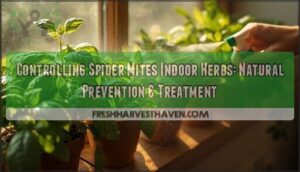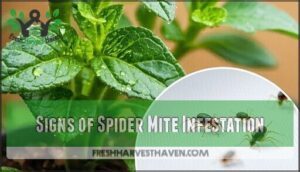This site is supported by our readers. We may earn a commission, at no cost to you, if you purchase through links.

Start by cranking up the humidity around your plants since these tiny troublemakers hate moist conditions. A daily misting routine or humidity tray works wonders.
For active infestations, insecticidal soap spray knocks them down fast, while neem oil provides longer-lasting protection.
Don’t forget the old-fashioned shower trick—blast affected plants with lukewarm water to physically remove mites and their webs.
Quick action is your secret weapon since these microscopic pests multiply faster than rabbits. The real game-changer involves understanding their sneaky hiding spots.
Table Of Contents
- Key Takeaways
- Spider Mite Biology
- Identifying Spider Mites
- Controlling Spider Mites
- Preventing Spider Mite Infestations
- Treating Spider Mite Infestations
- Frequently Asked Questions (FAQs)
- How to get rid of spider mites in indoor plants?
- What is a natural remedy for spider mites?
- Does basil repel spider mites?
- What is a natural killer for spider mites?
- What herbs keep spider mites away?
- How do you get rid of spider mites on indoor plants?
- How to remove spider mites from basil plants?
- How do you control spider mites naturally?
- How do you get rid of spider mites on basil?
- Do any plants repel spider mites?
- Conclusion
Key Takeaways
- Catch them early by checking leaf undersides weekly with a magnifying glass – spider mites can double their population in just one week, so quick detection saves your herbs from serious damage.
- Boost humidity above 60% using humidifiers, pebble trays, or grouping plants together – these pests hate moist conditions and thrive in dry indoor environments.
- Spray affected plants with insecticidal soap or neem oil every 3-5 days until they’re gone – these natural treatments suffocate mites without contaminating your cooking herbs.
- Quarantine new plants for 21 days and isolate infected ones immediately – prevention through plant isolation stops small problems from becoming garden-wide infestations, ensuring healthy herbs.
Spider Mite Biology
You’ll need to understand spider mite biology to fight these tiny pests effectively on your indoor herbs.
These microscopic arachnids reproduce at lightning speed and can destroy your herb garden before you even notice they’re there.
Physical Characteristics of Spider Mites
When you’re hunting down spider mites, understanding their mite appearance gives you a fighting chance.
These tiny arachnids measure just 1/50 inch—barely visible to the naked eye.
Spider mite size makes early detection tricky, but their arachnid features give them away:
- Eight legs (not six like insects)
- Oval-shaped bodies in red, yellow, or green mite colors
- Fine silk webbing signs across leaf surfaces
Their mite legs help them crawl rapidly across plants, while their protective webbing creates tiny silk highways between stems and leaves.
This leg count distinguishes them from other plant pests and confirms you’re dealing with spider mites, not aphids or thrips.
Life Cycle of Spider Mites
Understanding the spider mite life cycle gives you the upper hand in stopping infestations before they spiral out of control.
Knowledge beats chaos when it comes to spider mite control.
These tiny pests complete their entire lifecycle in just one week under warm conditions, making timing vital for effective treatment.
The Egg Development stage lasts 3-5 days, with females depositing up to 20 eggs daily on leaf undersides.
Next comes the Larval Stage (5-7 days), where young mites begin feeding immediately.
Nymphal Growth follows with two molting phases before reaching maturity.
Adult Reproduction is where things get serious – Mite Reproduction continues for 2-4 weeks non-stop.
This rapid Population Dynamics means colonies can double weekly, transforming a small problem into a plant-destroying nightmare.
Breaking this cycle at any stage protects your herbs effectively.
To manage spider mite infestations, to develop effective prevention strategies, understand common garden pests and their habits.
Spider Mite Behavior and Habitat
Spider mites act like tiny home invaders, choosing your spider mite habitat based on comfort alone.
These arachnids prefer habitat preference zones with low humidity and warm temperatures, making indoor herbs perfect targets.
Their spider mite behavior includes strategic web formation under leaves, creating protective silk highways for mite migration between plants.
Mite communication happens through chemical signals that guide reproduction patterns and colony expansion.
When conditions align perfectly, their reproduction patterns accelerate rapidly, turning a small spider mite infestation into a major problem.
Understanding their mite lifecycle preferences helps you disrupt their comfort zone and regain spider mite control over your herb garden.
Identifying Spider Mites
You’ll know spider mites have invaded your indoor herbs when you spot telltale signs that these tiny pests leave behind.
Early detection makes all the difference in saving your plants from serious damage.
Signs of Spider Mite Infestation
Now that you understand spider mite biology, let’s spot these tiny troublemakers before they wreak havoc on your herbs. Early detection means checking for infestation symptoms like stippling—those tiny pale spots where spider mite damage begins.
You’ll notice yellowing leaves first, followed by webbing signs in stem joints and leaf undersides. Plant decline happens fast once populations explode.
Key mite detection strategies include:
- Examining leaf undersides with a magnifying glass for moving specks
- Looking for fine silk threads between stems and nodes
- Checking for bronze-tinted leaf damage patterns
- Shaking leaves over white paper to spot falling mites
These spider mite infestation signs help catch problems early. Understanding common garden pests is essential for effective organic gardening practices.
Spider Mite Damage Signs
Telltale signs reveal when these tiny pests have moved in for good. Leaf Damage starts as small yellow dots that merge into bronze patches, creating a stippled appearance.
Spider Mite Symptoms worsen as leaves curl, dry out, and drop prematurely. Fine webbing between stems signals advanced Mite Infestation.
Plant Decline accelerates rapidly—your once-thriving herbs become stunted and weak.
- Yellow stippling that spreads across leaf surfaces
- Fine, silky Webbing Signs on stems and leaf undersides
- Premature leaf drop and brittle foliage texture
- Bronze or reddish discoloration replacing healthy green
- Stunted growth and overall Infestation Alerts
Inspecting Plants for Spider Mites
Once you’ve spotted the signs of spider mite damage, it’s time to become a plant detective. Effective leaf inspection starts with getting up close and personal with your herbs.
Grab a magnifying glass and check leaf undersides where spider mites love to hide. Look for tiny moving dots – that’s your first clue during plant examination. The mite detection trick? Gently tap leaves over white paper. If specks start crawling around, you’ve found them.
Focus your spider mite inspection efforts on new plants during their quarantine period. Weekly infestation checks prevent small problems from becoming big headaches. Spider mite signs include fine webbing around stems and leaf joints.
Mite behavior patterns help with timing – they’re most active during warm afternoons. Regular plant inspection using these spider mite prevention methods keeps your herbs healthy and pest-free.
Controlling Spider Mites
Once you’ve spotted spider mites on your indoor herbs, it’s time to take action before they turn your plants into their personal buffet.
You’ve got several effective control methods at your disposal, from gentle physical removal to targeted treatments that’ll send these tiny troublemakers packing.
You can use methods that range from gentle physical removal to more targeted treatments to control the spider mites.
Physical Removal Methods
Once you’ve spotted those pesky spider mites, it’s time to take action with your hands—literally.
Leaf Wiping with a damp cloth removes mites and eggs from herb surfaces effectively. Follow up with gentle Water Sprays to rinse away remaining pests, especially from leaf undersides.
For heavy infestations, Pruning Infestation areas stops the spread quickly. Vacuuming Mites from plant surfaces works too.
When plants are beyond saving, Plant Disposal protects your remaining indoor herbs from these persistent indoor herb pests through direct physical removal methods. Regular use of herb leaf wipes can help prevent future infestations.
Chemical Control Options
When physical removal isn’t enough, chemical pesticides offer powerful backup against stubborn spider mite colonies. However, these tools require strategic thinking to avoid creating bigger problems down the road.
Systemic pesticides work like plant vaccines, moving through your herb’s system to poison mites when they feed. Contact sprays hit mites directly but need thorough coverage to catch hiding populations.
Here’s your chemical control playbook:
- Rotate between different pesticide types to prevent resistance buildup
- Apply during cooler morning hours to minimize plant stress and maximize effectiveness
- Choose insecticidal soap over harsh chemicals when treating edible herbs
- Follow label directions precisely and make certain proper ventilation during application
Mite pesticides can be game-changers, but smart rotation prevents these tiny troublemakers from developing immunity. Avoid pyrethroid overuse, which actually boosts reproduction rates.
For a more sustainable approach, consider using natural pest control methods to maintain a healthy ecosystem.
Natural Remedies for Spider Mites
Nature offers powerful weapons against spider mites that won’t harm your herbs. Essential oils like rosemary and clove create hostile environments for these pests, while garlic spray paralyzes mites on contact. Neem oil disrupts their feeding and reproduction cycles effectively.
Diatomaceous earth sprinkled around plants creates a protective barrier. Companion planting with basil naturally repels mites through aromatic compounds. These herbal extracts and natural remedies mites solutions provide spider mite treatment without chemicals.
You’ll maintain safe herb pest control while protecting your kitchen herbs for cooking. For effective spider mite control, using a neem oil spray is a highly recommended approach.
Preventing Spider Mite Infestations
You can’t fight spider mites after they’ve moved in, so prevention beats treatment every time.
Smart habits like boosting humidity, checking plants weekly, and isolating newcomers will keep your herb garden mite-free.
Maintaining High Humidity
Spider mites despise high humidity, so you’ll want to maintain levels above 60% for effective natural pest control.
Here’s your game plan for creating the perfect mite control herbs environment:
- Humidifier Use – Run ultrasonic or evaporative models for consistent moisture
- Water Trays with pebbles beneath pots boost local Humidity Levels
- Pebble Trays create humidity zones around your indoor gardening tips setup
- Misting Plants lightly helps, but don’t overdo it
- Group plants together – they’ll naturally increase humidity through transpiration
This spider mite treatment approach keeps your herbs thriving while making life miserable for unwanted pests.
Regular Plant Inspection
Regular plant monitoring can make or break your battle against spider mites—think of it as your early warning system.
Weekly leaf checks help you catch these tiny troublemakers before they turn your herb garden into their personal buffet. Use a magnifying glass to spot the telltale signs lurking on leaf undersides.
Here’s your inspection checklist:
- Examine both leaf surfaces for fine webbing, stippling, or yellow specks
- Look for moving dots that scatter when disturbed—these are adult mites
- Check during dry spells when spider mite populations explode fastest
Focus your pest detection efforts on vulnerable spots where mites love to hide. These plant inspection techniques become second nature once you establish a routine, giving you the upper hand in spider mite prevention and keeping your indoor gardening tips working effectively.
Quarantining Infected Plants
Isolating infected plants prevents spider mite spread throughout your herb collection. Move affected plants away from healthy herbs, maintaining proper isolation methods to contain the outbreak.
Create a dedicated quarantine zone separate from your main indoor plant care area. Monitor quarantined plants daily for 21 days, watching for webbing, stippling, or mite movement. During quarantine procedures, apply neem oil or insecticial soap treatments every few days.
Disease containment requires patience, but plant recovery techniques can save mildly infected herbs. If infestation overwhelms a plant, disposal becomes necessary for mite infestation herbs prevention.
| Quarantine Step | Duration | Action Required |
|---|---|---|
| Initial Isolation | Day 1 | Move plant to separate room |
| Daily Monitoring | Days 1-21 | Check for new symptoms |
| Treatment Application | Every 3-5 days | Apply neem oil or soap |
| Recovery Assessment | Day 14 | Evaluate improvement progress |
| Final Clearance | Day 21 | Return to main collection if clear |
Treating Spider Mite Infestations
When spider mites have already invaded your indoor herbs, you’ll need to act fast with targeted treatments to stop their rapid reproduction.
These tiny pests can double their population in under a week, so combining multiple treatment methods gives you the best chance of winning this battle.
Insecticidal Soap Solutions
Anyone can whip up an effective spider mite killer using basic household items. Mix one to two tablespoons of pure liquid dish soap per gallon of water for maximum mite control. Apply this homemade solution every five to seven days, ensuring complete coverage of leaf undersides where mites hide.
For more effective control, understanding insecticidal soap properties is vital.
- Soap Concentrates: Use potassium-based soaps for gentler herb treatment
- Spray Applications: Target leaf undersides thoroughly for maximum effectiveness
- Treatment Frequency: Repeat weekly to catch newly hatched generations
- Soap Ingredients: Choose mild, unscented varieties to prevent leaf burn
Neem Oil Treatments
While insecticidal soap works well, neem oil treatments offer another powerful weapon against spider mites. This natural extract contains azadirachtin, which disrupts mite feeding and reproduction cycles effectively.
Mix one to two tablespoons of neem oil with a gallon of water for proper oil concentration. Add a few drops of dish soap to help the mixture stick. Treatment frequency should be every seven days until mites disappear completely.
Focus your spray application on leaf undersides where mites love to hide. Neem oil benefits include breaking pest life cycles without building mite resistance like chemical pesticides do. Apply during cooler morning or evening hours to prevent leaf burn.
Spray Remedies for Spider Mites
Dealing with spider mites on your indoor herbs doesn’t have to be overwhelming. Spray remedies deliver fast-acting relief when you’re facing a stubborn infestation.
These targeted treatments work by suffocating mites or disrupting their ability to feed on your precious plants:
- Soap Sprays: Mix three tablespoons of liquid dish soap per gallon of water for effective contact control
- Oil Blends: Apply neem oil products or horticultural oils to smother mites and their eggs completely
- Mite Repellents: Create homemade pest spray using rosemary or garlic extracts as natural deterrents
Spray frequencies matter—reapply every three to five days until you’ve eliminated the infestation completely.
Biological Control Methods
Nature’s army awaits deployment in your indoor herb garden.
Predatory mites like Phytoseiulus persimilis consume up to 200 spider mite eggs daily, delivering swift parasite introduction results.
These biological controls work best with proper humidity levels, making microbial controls and integrated pest management strategies highly effective without chemical intervention.
Ladybugs and lacewings patrol continuously, creating sustainable natural enemies networks.
Integrated Pest Management Strategies
Success hinges on combining multiple spider mite control strategies through integrated pest management. Think of it as building layers of defense rather than relying on one silver bullet.
Your IPM toolkit should include:
- Pest Monitoring – Weekly inspections with a 10× hand lens
- Biological Controls – Predatory mites like Phytoseiulus persimilis
- Organic Pesticides – Neem oil and insecticidal soaps
- Soil Management – Proper drainage and debris removal
- Natural Pest Repellent – Essential oils and companion planting
This thorough approach prevents resistance while protecting your pest management herbs naturally. Effective pest control methods are vital for maintaining healthy indoor herbs.
Frequently Asked Questions (FAQs)
How to get rid of spider mites in indoor plants?
Spider mites can double their population weekly in warm, dry conditions.
You’ll need to spray affected plants with insecticidal soap or neem oil, increase humidity above 60%, and repeat treatments every 3-5 days until they’re gone.
What is a natural remedy for spider mites?
Mix three tablespoons liquid dish soap with one gallon water and spray plants thoroughly. Neem oil disrupts their life cycle, while essential oils like peppermint or rosemary repel them naturally.
Does basil repel spider mites?
Think of basil as your garden’s bodyguard—it naturally repels spider mites through its strong aromatic oils.
You’ll find companion planting basil near susceptible herbs creates a protective barrier that deters these tiny pests effectively.
What is a natural killer for spider mites?
Neem oil disrupts their life cycle, while insecticidal soap suffocates them on contact. You can also spray a strong water stream to physically remove these pests from your plants.
What herbs keep spider mites away?
Want your herb garden mite-free? Plant basil, garlic, and chrysanthemums nearby—they’re like natural bouncers for your plants.
These aromatic herbs create an invisible shield that spider mites can’t stand, keeping your indoor garden thriving with chrysanthemums.
How do you get rid of spider mites on indoor plants?
Start by spraying plants with water to knock mites off, then apply insecticidal soap or neem oil every three days. Increase humidity and inspect regularly.
How to remove spider mites from basil plants?
Like battling an invisible army, you’ll need to spray your basil with insecticidal soap every three days, rinse leaves with strong water, and increase humidity to win this war.
How do you control spider mites naturally?
You can fight spider mites naturally using water sprays, neem oil, insecticidal soap, or essential oils like peppermint. Boost humidity above 60%, introduce predatory mites, and remove infested leaves promptly.
How do you get rid of spider mites on basil?
Spray your basil with water to knock off mites, then apply insecticidal soap or neem oil. Remove heavily infested leaves immediately. Increase humidity and repeat treatments every three days.
Do any plants repel spider mites?
Yes, several plants naturally repel spider mites. Garlic, chrysanthemums, basil, and other aromatic herbs deter these pests when grown nearby. You can also use companion planting strategically around vulnerable plants.
Conclusion
Spider mites reproduce incredibly fast—females can lay up to 20 eggs daily in warm, dry conditions.
Successfully controlling spider mites on indoor herbs requires quick detection and consistent treatment.
You’ll get best results combining multiple approaches: boost humidity levels, spray with insecticidal soap weekly, and inspect plants regularly for early signs.
Remember to quarantine new plants and maintain good air circulation.
With persistence and the right natural methods, you can keep your culinary herbs healthy and mite-free year-round.











